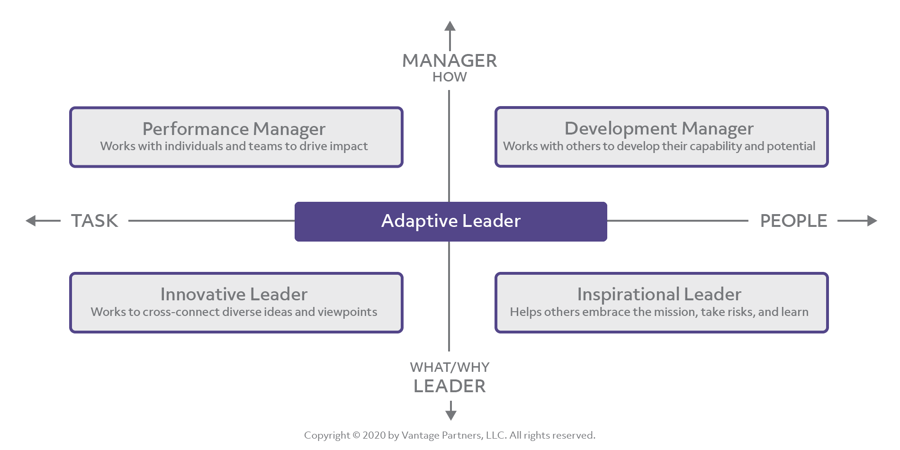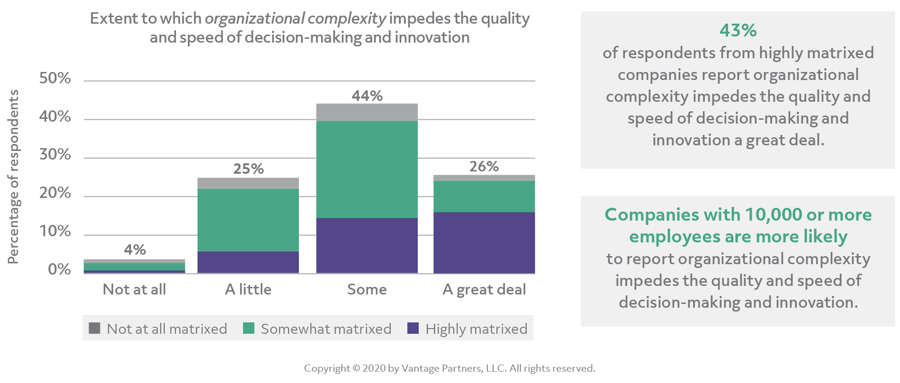In this ever-changing world in which we work, effective leaders possess the skills to look ahead, spot the trends, anticipate the appropriate course of action, and nimbly adjust to maximize success. They are adaptive leaders. But they also know they do not possess all the answers. Instead, they are comfortable with ambiguity, curious rather than certain, persuasive yet open to others’ ideas and influence. As they develop and hone these truly differentiating skills, they are better able to manage complexity and navigate dynamic business ecosystems, especially inside their own organization. Adaptive leaders learn not to shy away from or paper over conflict, but instead seek to explore differences and creatively solve problems through collaboration.
Leaders, more than ever, must be present, agile, just in time, in the moment. In the future unfolding before us now, these behaviors reflect the mindset and the adaptive, collaborative skills that are fundamental to any role, at any level; they represent the underlying capabilities that animate great leadership teams; they are the secret sauce that makes a leadership system actually work in practice.
Every leader possesses a particular mindset. That mindset—what and how leaders think and feel about their role, their people, their goals—drives what they say and do. Leaders can’t just be told what to do—“now it’s time to adapt and collaborate!”—or merely instructed to adopt or change any other fundamental behaviors. Such directed behavior changes might last for a while, until people forget and their underlying mindsets retake the reins. Sustained behavior change requires sustained mindset shift.
Vantage Partners has worked with thousands of leaders from multiple industries across the globe. We have observed four fundamental mindset shifts that leaders must make to move from a traditional leader to an adaptive, collaborative leader.
Hallmarks of adaptive, collaborative leaders include curiosity, creativity, clear intentions, and a relentless focus on solving problems—whether it’s in relation to people, partnership, process, or business challenges. In action, adaptive leaders eagerly pursue shared accountability—and clarity of roles and responsibilities—to drive measurable and reliable impact. A culture of adaptive, collaborative leadership reinforces itself. It brings together good-willed, hard-working, frank-yet-generous, conversation-having individuals, teams and leaders who motivate and inspire each other to perform at their highest potential.
Sometimes leadership is merely positional. The person-in-seat marshals teams and individuals to achieve goals by resting into the hierarchy defining the role. Leading, however, is not about status, title, or tenure. Leadership is the human side of business. It is about behavior. Leadership is the how and the why. It’s how the leader engages with his or her team, peers, and managers to produce results while simultaneously aligning people to a vision and keeping the bigger picture in mind.
When adaptive leaders develop the fundamental skills to accelerate collaboration, they help themselves, their direct reporting teams, and their cross-functional teams. They replace one-way communications with two-way problem-solving; they make dialogue more productive; they remove organizational barriers that a lack of communication and poor coordination create. Adaptive leaders align individuals and teams behind strategies that—when operationalized—advance the business. They accelerate performance through being adaptive. 
Adaptive leaders serve in not just one role, but rather play multiple roles in their daily work depending on their context and purpose on the team and in the business. Sometimes leaders manage—driving performance, holding themselves and others accountable, and helping others perform better. At other times, leaders lead by connecting: They connect the dots among ideas and augment the connections among people to foster innovation. Sometimes they inspire others to higher purpose—to take risks, to do the right thing in the face of adversity, to do their best for the company.
Indeed, adaptive leadership encompasses each of these situational leadership roles. They also embrace the core leader’s role of working with others to achieve the “360-degree win-win”—for themselves, for others, and for the company. Adaptive leaders can be inspirational, innovative, and good people managers, because they approach every role they play from this win-win mindset interwoven with a service mindset.
Successful leaders today behave in ways that help them, those with whom they work, and their organizations thrive amidst uncertainty, complexity, and change. As adaptive leaders, they avoid getting “lost in the matrix organization.” Instead, they manage the matrix—the predominant design for organizations of all sizes today, according to a six-year Vantage Partners study. More than 70% of the study’s 750-plus respondents, reflecting a diverse cross-section of more than 500 companies, report that complexity impedes the quality and speed of decision-making and innovation in their organizations “some” or “a great deal.” This complexity can create conflict and make it difficult for leaders to work with other seemingly unreasonable counterparts.
 Other essential behaviors of leaders include the ability to influence, build trusting relationships, and collaborate with others. Leaders today—at every organizational level—adapt and creatively solve problems. And just as adaptive, collaborative leaders perform multiple roles, they also approach leadership on multiple levels—namely, as leaders of themselves, of their teams, and of the business.
Other essential behaviors of leaders include the ability to influence, build trusting relationships, and collaborate with others. Leaders today—at every organizational level—adapt and creatively solve problems. And just as adaptive, collaborative leaders perform multiple roles, they also approach leadership on multiple levels—namely, as leaders of themselves, of their teams, and of the business.
The leader of self is self-aware, possessing the emotional intelligence to manage his or her own emotions—and those of others. Self-leadership starts with knowing one’s role, owning one’s style, demonstrating trustworthiness, and building one’s resilience for the turbulent voyage of leading through accelerating change.
The leader of others manages teams and drives performance. Leading others on the team involves not just prioritizing and delegating tasks and managing commitments, but also requires communicating in ways that motivate, inspire, and build trust; aligning around a shared vision and finding a common destination for often diverse voyages; and harnessing the friction of creative differences and conflict to spark action and innovation.
The leader of the business navigates the organization and across its external landscape of partners, alliances, customers, and other stakeholder relationships. Those who lead the business “lead according to need.” Leading the business elevates the key elements of team leadership to the cross-organizational level, aligning tasks, behaviors, and goals of the self and team behind the mission and goals of the organization.
Organizations often ascribe to a model of leadership—yet can struggle to breathe life into that model and enliven it with actual people who behave in the image, or with the intent, of the model. Like mission statements, leadership models can hang on the wall for decades (literally or figuratively), yet they don’t matter unless people behave in alignment with them.
Leadership development, then, needs to be “livable”: relevant, realistic, relatable, and applicable. Leaders should not be lone actors on a stage, but rather integrated parts of the greater organizational whole. Thus, leaders need to be developed for the context in which they serve.
Answering these questions is less about having an articulated or specific leadership model or framework. Rather, it is about leaders seeing themselves, others, and the business in context. It is about being curious to discover what is needed at that moment, in that specific context, and showing up accordingly. This is the essence of developing—and living—adaptive, collaborative leadership.
All material contained on this website (except where noted) © Copyright 2024 Vantage Partners, LLC. All rights reserved.
+1.617.904.7800